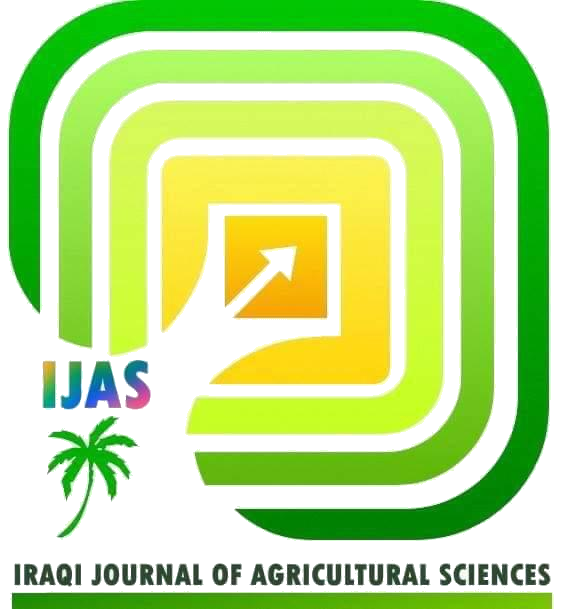EFFECT OF THE PLASTIC COVER COLOR AND ELECTROCUTION IN ROOT GROWTH INDICATORS AND VOLATILE OILS CONTENT OF THE TANACETUIM PARTHENIUM L.OF PLANT ROOTS
DOI:
https://doi.org/10.36103/w1qc0x41Keywords:
Camphor و Campheneو P-CymeneAbstract
This research was carried out in the scientific experiments field of the Faculty of Agriculture - University of Baghdad, during the agricultural season 2015-2016 to study the effect of the plastic cover color and electrocution in root growth indicators and the volatile oils content of the roots, the research was done according to the randomized complete block design (RCBD) within .Split plot design. The first factors .(Main plot)was the plastic cover color (transparent, yellow, red and blue) and the second factor (Sub plot. incorporates four levels of stressed electrocution (0,2,4, 6 Amp) for 4 minutes, thereby resulting 48 experimental units (4 × 4 × 3) as the experimental unit contains 10 plants. The differences amonge means were tested using LSD at a level of probability of 0.05. The results showed superiority of the plants growing under a yellow cover (Y) in the root growth indicators, which included root length and surface area of the roots and weight mild and dry (20.41 cm and 0.943 dcm2 and 111.1 g and 47.32 g) and the content of the roots of the volatile oils, which included Camphor ,Camphene and P-Cymene (5.514 µg.g-1 and 1.317 µg.g-1 and 0.693 µg.g-1) and the superiority of electric shock treatment level (4Amp) a significant increase in root growth indicators and the content of the roots of the volatile oils (25.58 cm and 90.09 g and 143.99 and 56.73 and 1.466 µg.g-1and 0.782 µg.g-1and 0.380 µg.g-1), respectively, resulted in the treatment of overlap between the color of the cover electric stun significant effect on root growth indicators and the content of the roots of the volatile oils, it outperformed the treatment of overlap (YA2) a significant increase in root surface area of the roots of the length, weight mild, dry weight and content of the roots of Camphor and Camphene and P-Cymene (27.00 cm and 1.426 dcm 2 and 160.32 g 72.59 g and 2.998 µg.g-1 and 2.100 µg.g-1 and 0.895 µg.g-1), respectively. It can be conclude that of the plastic cover color and electric shocks had significant effect on growth and stimulate the prodaction of volatile oils in plant roots.
References
1. Alsahoeke, M.and K.,M.Wahib. 1990. Applications in the Design and Analysis of Agricultural Experiments. Ministry of Higher Education and Scientific Research of Iraq.pp480.
2.Chappell, J. and R. Mcoates. 2010. Sesquiterpenes Comprehensive Natural Products II, Chemistry and Biology 1, p:609-641.
3. Cherbah, M.1996. Radiation in Food and Agriculture Technology. The Arab Organization for Agricultural Development and the Arab Authority for Energy Aldhirah. pp: 599.
4.Devlin, R. and M., Francis. 1998.Plant Physiology.The 2nd edition translation Hraca Mohamed Mahmoud, Abdul Hadi al-Khader, Ali SaadEddin safety and Nadia Kamel. Arab House for publication and distribution. Egypt.p.350-351.
5.Kusin, M. 1973.Molecular mechanism of stimulation effect of ionizing radiations of plant seeds. Radiology 5: 636-643.
6.Mojab, F., S.Tabatabai, A. Naghdi-Badi, H., Nickavar and F. Ghadyani,. 2007. Essential oil of the root of Tanacetum parthenuim L. Schulz. Bip.(Asteraceae) from Iran. Iranian Journal of Pharmaceutical Research, 6(4):291-293.
7. Robert , A. 2007.Electro culture(The Electical Tickle ).The Title 17 U. S. C. Section 107.18(23):1-11.
8.Quintans, J., D. Menezes, P., Santos, M. Bonjardim, L. Almeida, J. Gelain and D. Quintans-Júnior. 2013. Improvement of p-cymene antinociceptive and anti-inflammatory effects by inclusion in β-cyclodextrin. Phytomedicine, 20(5), 436-440.
9.Nelson,A.2000.Electro-Culture (Chapter 5) .Internet edition.pp:728-730.
10. Sharopov, F., S. Setzer, N. Isupov and M. Wink.2015. Composition and bioactivity of
the essential oil of Tanacetum parthenium from a wild population growing in Tajikistan. Am. J. Essent. Oils Nat. Prod.
11.Sysoeva, M., I. Markovskaya, and T.Shibaeva . 2010. Plants under continuous light: a review. Plant stress Global Science Books, 4(1), 5-17.
12.Taiz, L. and E. Zeiger. 2010. Plant physiology. 4th. ed. Sinauer Associates, Inc. publisher Sunderland, Massachus- AHS. U.S.A.pp:225-226.
13.Tosun, A., S.Khan, Y.Kim, S. Calín-Sánchez, Á., Hysenaj, X., and A .Carbonell-Barrachina. 2014. Essential Oil Composition and Anti-Inflammatory Activity of Salvia officinalis L. (Lamiaceae) in Murin Macrophages. Tropical Journal of Pharmaceutical Research, 13(6), 937-942.
14.Vasilevski,G.2003.Perspectives the application of biophysiological methods in sustainable agriculture. Bulg. J. Plant Physiol. Special Issue. pp: 179-186.
15.Zuccarini, P. 2009. Camphor: risks and benefits of a widely used natural product. Journal of Applied Sciences and Environmental Management. 13(2):69-74.
Downloads
Published
Issue
Section
License
Copyright (c) 2025 IRAQI JOURNAL OF AGRICULTURAL SCIENCES

This work is licensed under a Creative Commons Attribution-NonCommercial 4.0 International License.

2.jpg)
 https://orcid.org/0000-0002-5774-5906
https://orcid.org/0000-0002-5774-5906 



